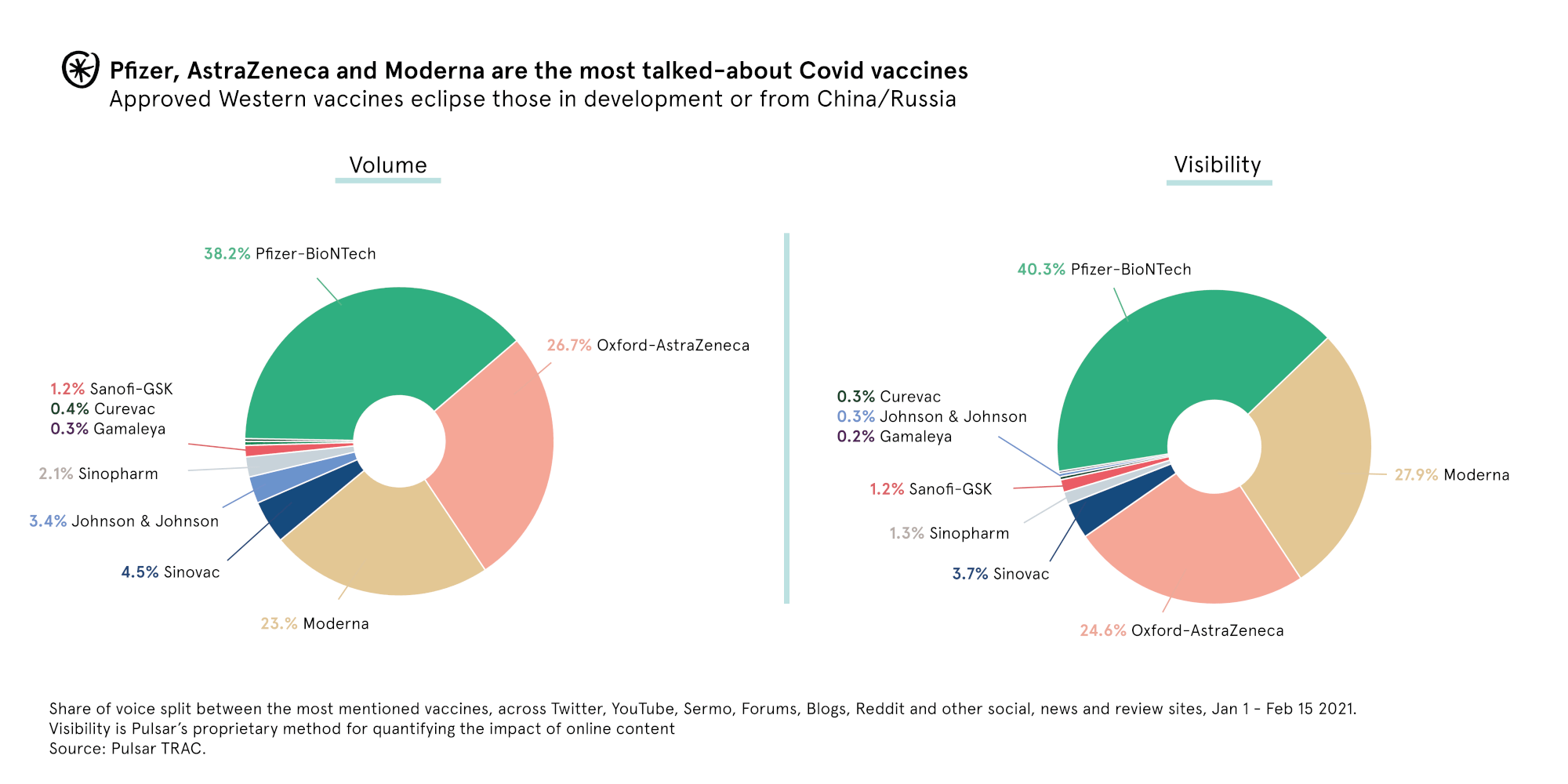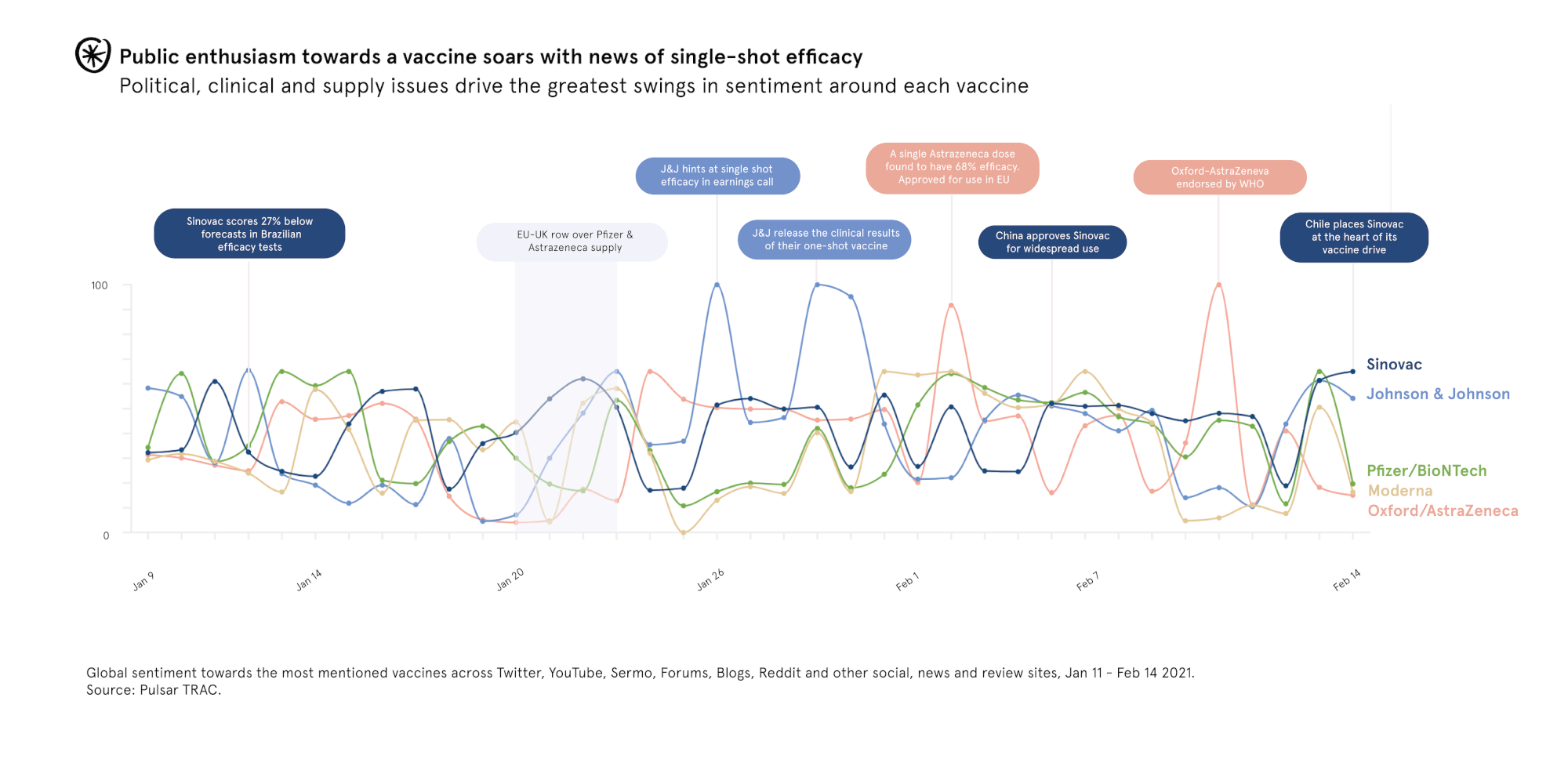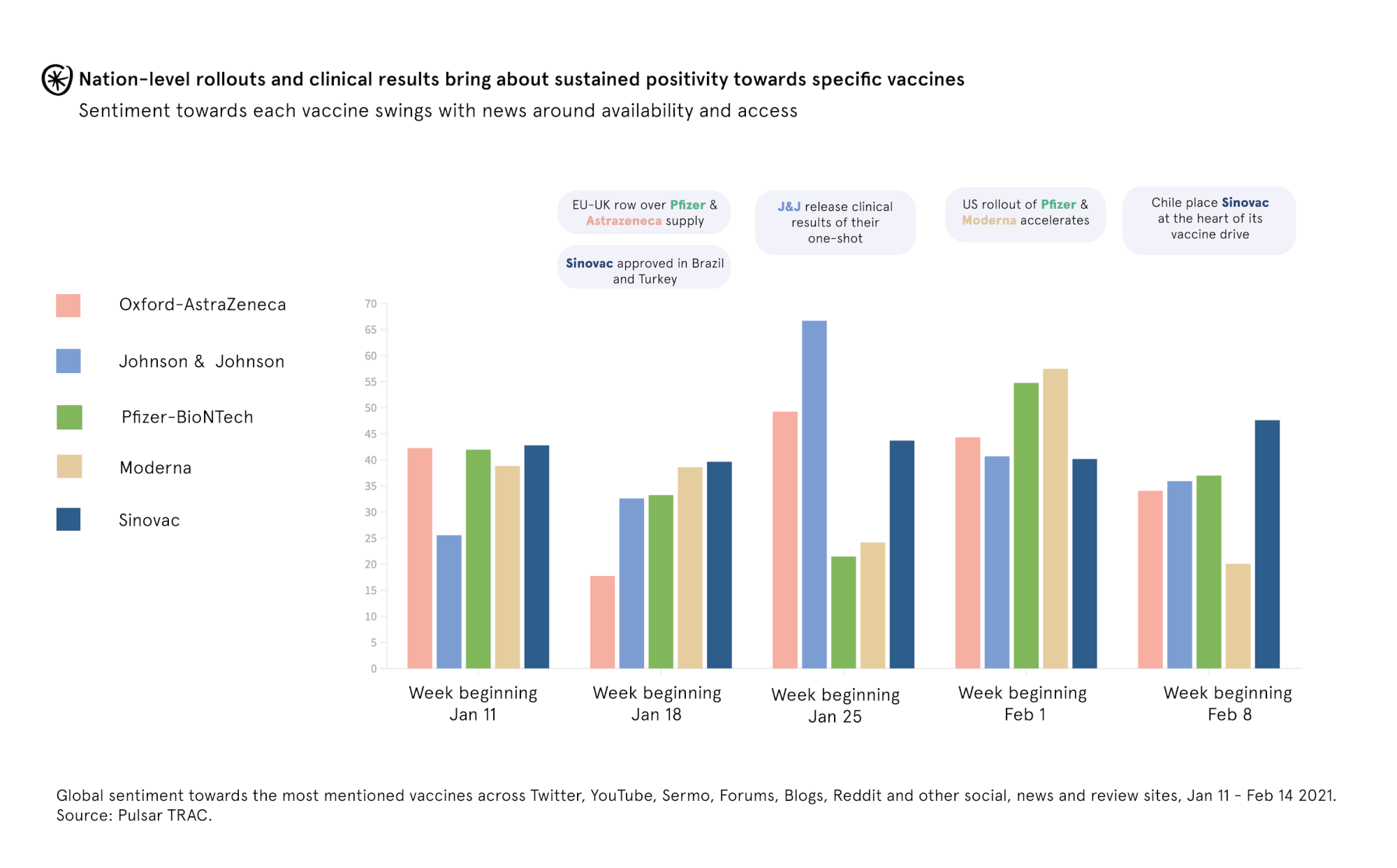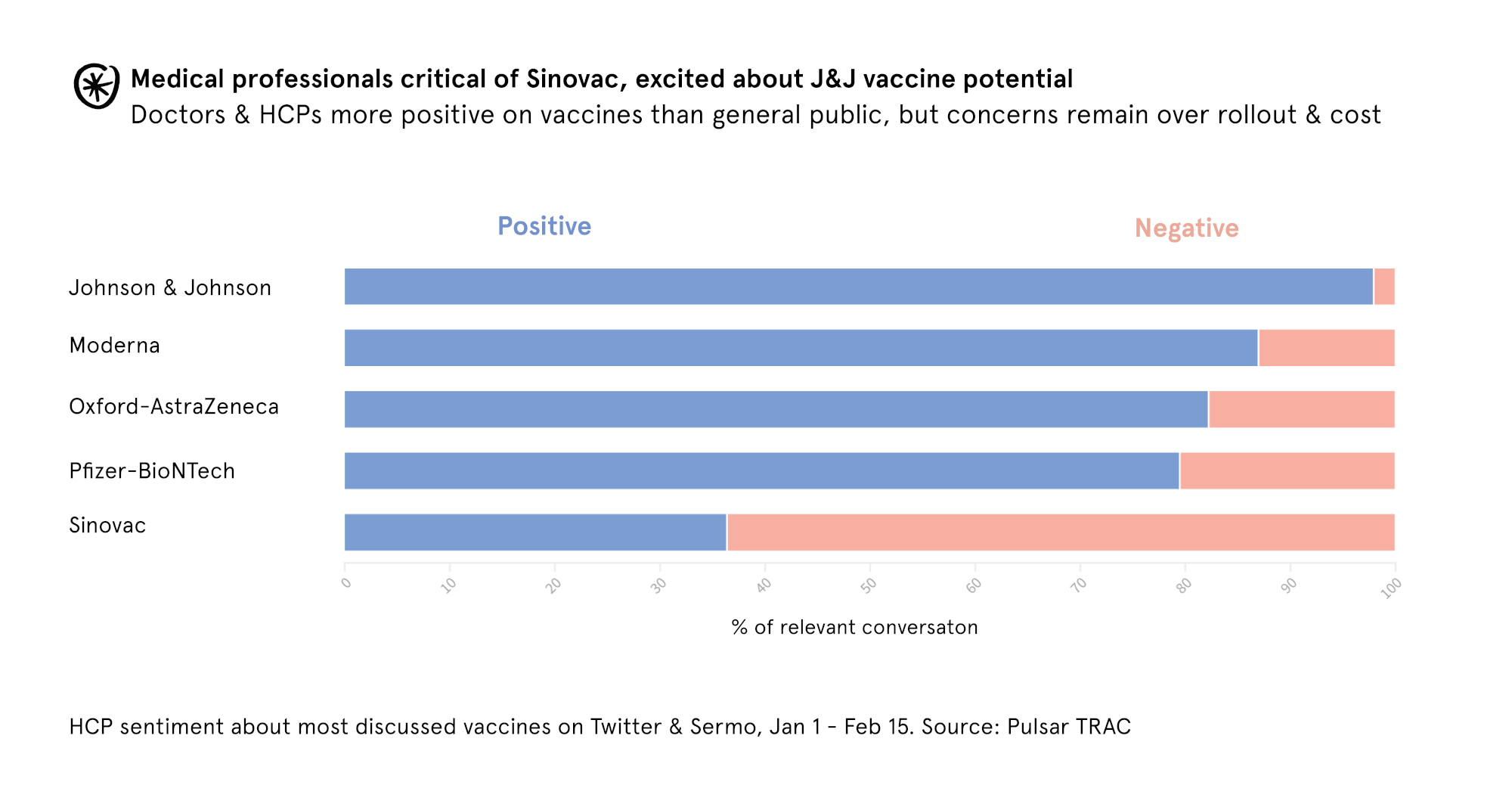The Covid Vaccine Sentiment Index: tracking public attitudes toward each vaccine
Find the most recent update (March 11) to the Index here
Covid vaccines are being rolled out globally, in the largest coordinated healthcare push the world has ever seen.
But how do people feel about the different vaccines?
In this index, we set out to measure and monitor the public opinion and attitudes by analyzing social, news and forum mentions of each vaccine. In particular, we looked at:
- The public perception of each Covid vaccine
- How doctors and healthcare professionals’ sentiment about each vaccine differs from the public’s
- Which events are affecting sentiment swings for Covid vaccines
First off - which vaccines are being talked about the most?
In our analysis over the first 90 days in 2021, of over 1 million posts, Pfizer-BioNTech, Oxford-AstraZeneca and Moderna dominated the online conversation, accounting for around 90% of the vaccine conversation, both in terms of volumes and in terms of visibility – our proprietary metric estimating how many people have seen a given piece of content.
But if mass vaccine adoption is the goal, sentiment around the conversation of each vaccine is more important than volume or visibility: vaccine skepticism, hesitancy and rejection, which we already began to measure across US cities, could prove one of the biggest obstacles on the road to exit this pandemic.
Over the course of the past five weeks, we scored daily sentiment for each vaccine on a 0-100 scale, based on the perceived opinion of social media, news and forum posts around each of the 5 most-talked-about vaccines.
Tracking sentiment for each vaccine brand on a day-by-day basis –with a methodology similar to the Drug Sentiment Index we offer on Bloomberg– allows us to spot how news developments affect the public opinion about each vaccine: the clinical approval of single-dose shots is the most significant driver of positive public opinion, with both Johnson & Johnson and Oxford-AstraZeneca the beneficiaries in different weeks.
Because its vaccine is still in development, Johnson & Johnson in particular seemed able to control the narrative around its vaccine better than others – with the first and highest spike in sentiment coming at hints of its single-shot in the company's earnings call.
At the same time, the daily tracker allows us to see negative impact of national squabbles over supply and distribution: sentiment around both the Pfizer-BioNtech and Oxford-AstraZeneca vaccines dropped in late January when the EU and the UK entered a very public row over the provisioning of vaccine doses.
As the nationality of each vaccine came into focus, vaccine nationalism emerged on other issues as well, with a wave of support from the UK to defend the supposed effectiveness of 'their' Oxford-AstraZeneca vaccine.
https://twitter.com/Dailybugle1898/status/1354489039274053637
Similar trends around each vaccine brand become evident when looking at sentiment on a week-by-week basis: developments around supply and accessibility emerge as one of the main drivers of sentiment around each vaccine.
So while Johnson & Johnson’s successful trial caused global optimism to spike about the world’s imminent access to a single-dose shot, the above-mentioned UK/EU row meant Oxford-AstraZeneca endured the single greatest dip, in the week of Jan 16th.
Shortly afterwards, Moderna and Pfizer-BioNTech, the two brands with US-certified vaccines, enjoyed an increase in sentiment as rollouts accelerated across the United States. At the same time in the US conspiracy theories around both those flourish.
https://twitter.com/risetoflyy/status/1355262114143858689
Sinovac, meanwhile, remains remarkably stable week over week, with only mild swings resulting from clinical data or national approvals around the world: Chile's effective rollout of Sinovac for instance, or approvals of the drug in Cambodia and Thailand.
This influential post, for instance, compares the rollout of Sinovac in Chile to a supposedly much slower one in France.
https://twitter.com/RaquelGarridoFr/status/1360937811801747463
Overall, this is a news-driven conversation, with British newspapers in particular helping to influence what information is shared and taken as fact.
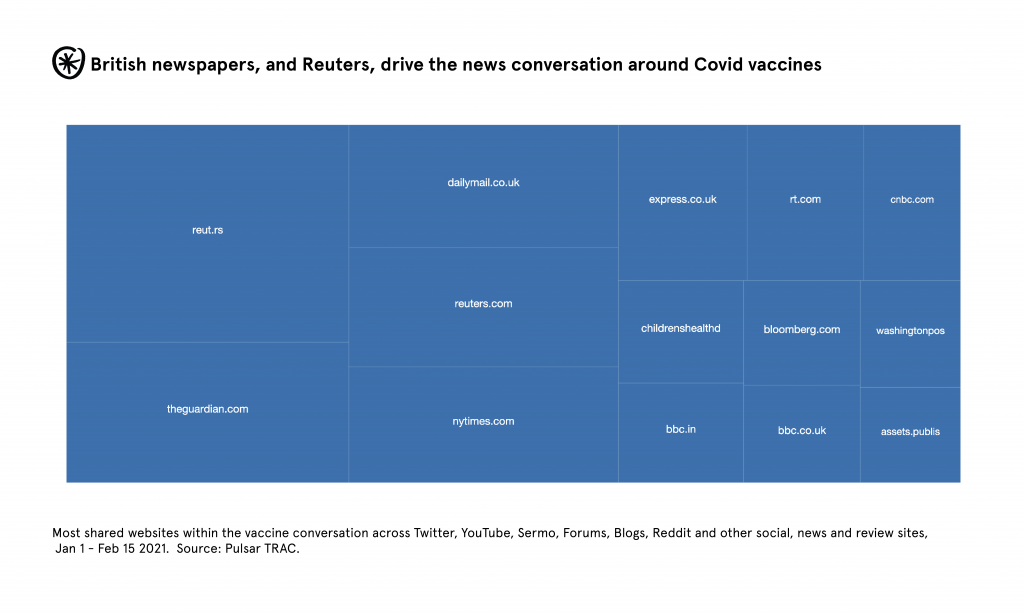
The medical and healthcare professional (HCP) conversation
While opinions about each Covid vaccine are shaping up among the public, medical professionals are also debating each vaccine’s effectiveness, side effects, and rollout.
Taking a look at emotions displayed by health care professionals on Twitter and on Sermo (note that in the below chart we are measuring sentiment differently than in the other graphs), emotions tend towards the overwhelmingly positive, given the incredible scientific achievement of the development.
As the spread of scientific information becomes a public health issue, certain doctors with a large audience don't shy away from highlighting different vaccine's virtues, and touting the scale of the scientific accomplishment.
https://twitter.com/ScottGottliebMD/status/1355139722646081537
Others decide to use their platforms to critique the strategic decisions made within their respective countries. This partly explains the predominantly negative sentiment towards Sinovac, as doctors in countries like the Philippines question the soundness of their governments' agreements with the Chinese manufacturer.
https://twitter.com/gideonlasco/status/1348495302672584704
But not all doctors are so active on social media. Our exclusive partnership with Sermo –the physicians’ social network– allows us to analyze (anonymized) posts by global verified HCPs and to zoom into what doctors around the world are saying about individual vaccines.
Overall, the Sermo conversation amongst HCPs tends to focus on vaccine effectiveness, questions around edge cases (e.g. pregnancy, chemotherapy) and questions around the most effective rollout strategies.
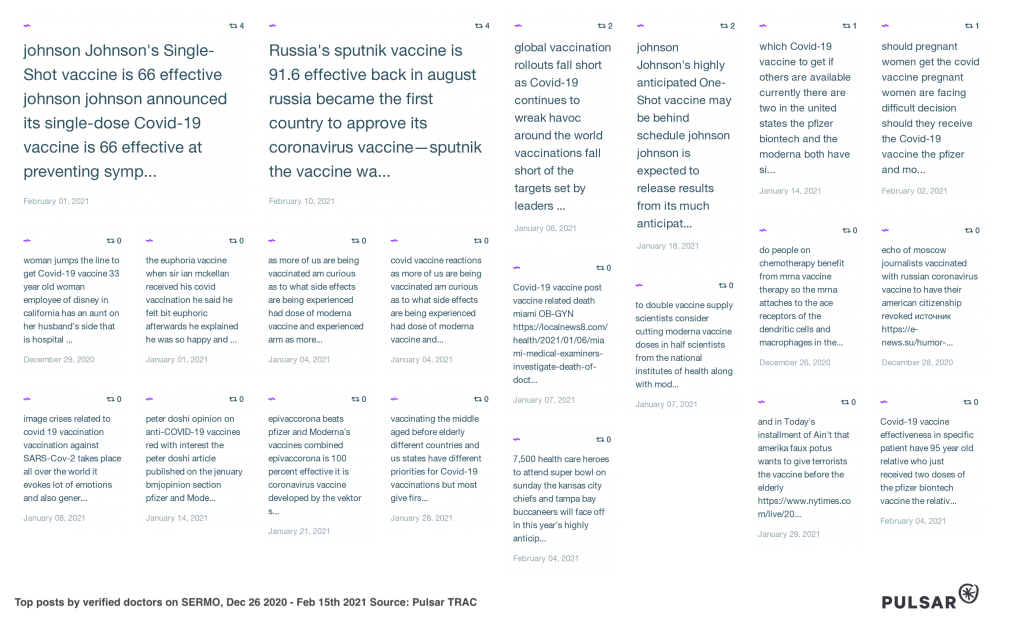
As sentiment hardens into behavior, the conversations taking place online provide an indicator of the world’s attitudes towards different vaccines. We’ll continue to explore and update the Covid Vaccine Sentiment Index in the coming weeks.
If you'd like to discover more about this dataset or its methodology, and would like to understand the range of our data sources –including Sermo– to understand the healthcare and pharmaceutical conversation you can request a demo with one of our specialists today.
